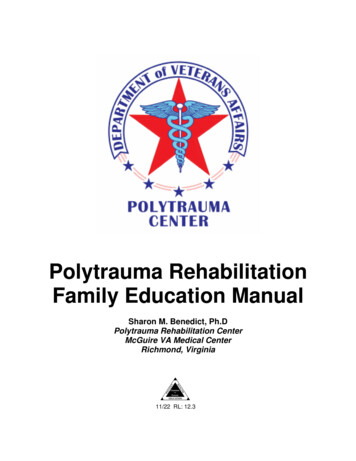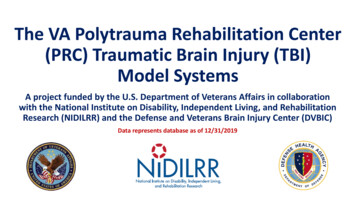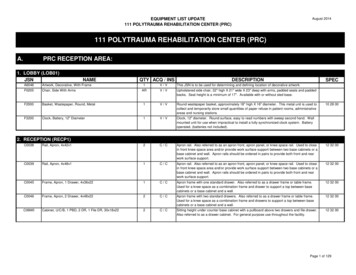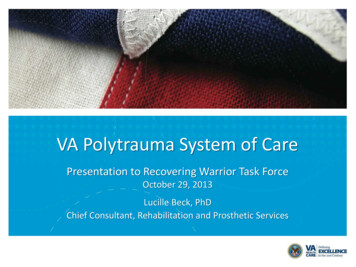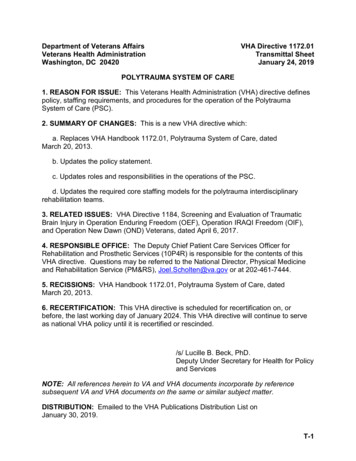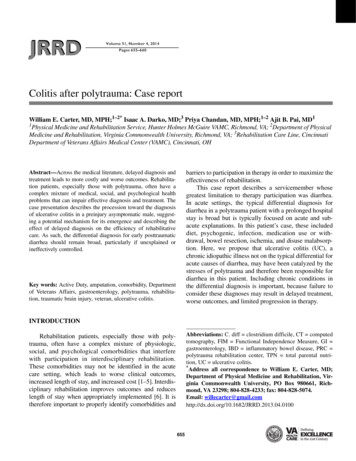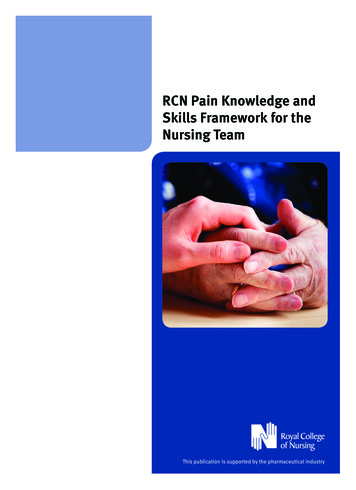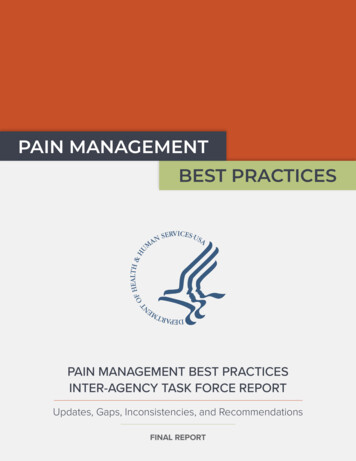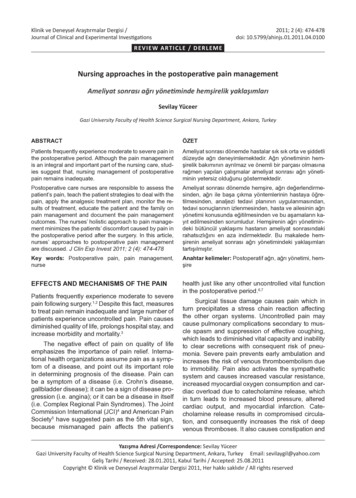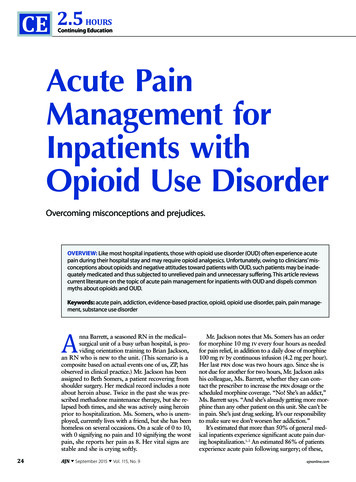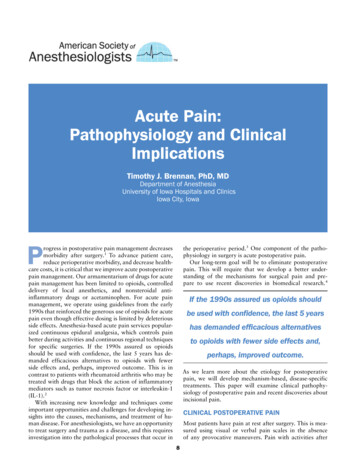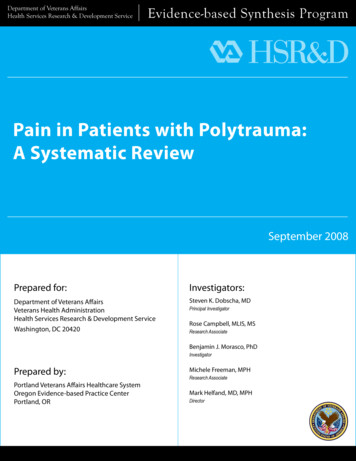
Transcription
Department of Veterans AffairsHealth Services Research & Development ServiceEvidence-based Synthesis ProgramPain in Patients with Polytrauma:A Systematic ReviewSeptember 2008Prepared for:Investigators:Department of Veterans AffairsVeterans Health AdministrationHealth Services Research & Development ServiceWashington, DC 20420Steven K. Dobscha, MDPrincipal InvestigatorRose Campbell, MLIS, MSResearch AssociateBenjamin J. Morasco, PhDInvestigatorPrepared by:Michele Freeman, MPHPortland Veterans Affairs Healthcare SystemOregon Evidence-based Practice CenterPortland, ORMark Helfand, MD, MPHResearch AssociateDirector
Pain in Patients with PolytraumaPREFACEVA’s Health Services Research and Development Service (HSR&D) works to improve thecost, quality, and outcomes of health care for our nation’s veterans. Collaborating with VAleaders, managers, and policy makers, HSR&D focuses on important health care topics thatare likely to have significant impact on quality improvement efforts. One significantcollaborative effort is HSR&D’s Evidence-based Synthesis Program (ESP). Through thisprogram, HSR&D provides timely and accurate evidence syntheses on targeted health caretopics. These products will be disseminated broadly throughout VA and will: inform VAclinical policy, develop clinical practice guidelines, set directions for future research toaddress gaps in knowledge, identify the evidence to support VA performance measures,and rationalize drug formulary decisions.HSR&D provided funding for the two Evidence Based Practice Centers (EPCs) supportedby the Agency for Healthcare Research and Quality (AHRQ) that also had an active andpublicly acknowledged VA affiliation—Southern California EPC and Portland, OR EPC—so they could develop evidence syntheses on requested topics for dissemination to VApolicymakers. A planning committee with representation from HSR&D, Patient CareServices, Office of Quality and Performance, and the VISN Clinical Management Officers,has been established to identify priority topics and to ensure the quality of final reports.Comments on this evidence report are welcome and can be sent to Susan Schiffner, ESPProgram Manager, at Susan.Schiffner@va.gov.VA-ESP September 2008ii
Pain in Patients with PolytraumaEXECUTIVE SUMMARYBACKGROUNDPain resulting from polytraumatic injuries poses numerous challenges during and afterrehabilitation treatment. The objectives of this report are to systematically review theliterature to address the assessment and management of pain in patients withpolytraumatic injuries, to identify patient, clinician and systems factors associated withpain-related outcomes in these patients, and to describe current or planned researchaddressing the key questions in this report.The key questions were:1. Have reliable and valid measures and assessment tools been developed to measurepain intensity and pain-related functional interference among patients withcognitive deficits due to TBI? Which measures and tools are likely to be mostuseful in assessing pain in polytrauma patients with cognitive deficits due to TBI?2. A. Which treatment approaches are most likely to be effective in improving painoutcomes (pain intensity and functional interference) in polytrauma patients?B. Which pain treatment approaches are most likely to enhance overallrehabilitation efforts?3. A. Does blast-related headache pain differ in terms of phenomenology andtreatment from other types of headache pain?B. Which treatments are best for persistent blast-related headache pain?4. What patient factors are associated with better and worse pain-related clinicaloutcomes among polytrauma patients? Have interventions been developed tospecifically address these factors?5. What are unique provider and system barriers to detecting and treating pain amongpolytrauma patients? Have interventions been developed to effectively addressthese barriers?We also sought to identify and describe current or planned research that is addressing orwill address the key questions.METHODSLiterature SearchTwo research librarians independently designed search strategies based on the keyquestions, and conducted searches in Medline of literature published from 1950 throughJuly 2008. The results of both searches were combined into a single reference library.Three researchers trained in the critical analysis of literature assessed for relevance theabstracts of citations identified from these literatures searches. Full-text articles ofpotentially relevant abstracts were retrieved for further review. Reference lists fromVA-ESP September 2008iii
Pain in Patients with Polytraumaarticles were reviewed to find additional articles for inclusion. We also searched for inprogress and unpublished trials. Due to a limited number of studies using controls orcomparators, we included cross-sectional and case report/case series studies in the reviewfor some key questions, We systematically rated the quality of cohort and case-controldesign studies.Active ResearchThe PI sent email communications inquiring about active or planned research to a numberof groups and individuals identified through VA workgroups, personal knowledge ofinvestigators, recent publications, and several web-databases which included informationabout funded VA and non-VA projects. Email communications described the evidencereview project, and asked respondents to describe any relevant projects they were involvedin or planning as well as to identify other investigators who might be working in theseareas (snowball approach). Initial email messages were sent at the end of January 2008;email messages to newly identified investigators and follow-up communications occurredcontinuously until August 28, 2008.RESULTSWe screened 3252 titles and performed a more detailed review of 578 articles. From these,we identified one systematic review, one qualitative research study, and 93 observationalstudies that addressed at least one of the key questions. Studies were excluded for thefollowing reasons: 1) the study population did not constitute or include polytraumapatients or patients with blast-related headaches; 2) the study addressed perioperative orsurgical pain management or management of specific orthopedic injuries or only short term(less than 3 months post-injury) outcomes; 3) the study outcomes did not include measuresof pain intensity or pain-related function; 4) the text of the article was non-English. Theprimary findings for each key question are summarized below. Secondary findings arepresented in further detail within the report.KEY QUESTION #1 Have reliable and valid measures and assessment tools beendeveloped to measure pain intensity and pain-related functional interference amongpatients with cognitive deficits due to TBI? Which measures and tools are likely to bemost useful in assessing pain in polytrauma patients with cognitive deficits due to TBI?There were no published studies that assessed measures of pain intensity or painrelated functional interference among patients with cognitive deficits due to TBI.KEY QUESTION #2 A. Which treatment approaches are most likely to be effective inimproving pain outcomes (pain intensity and functional interference) in polytraumapatients? B. Which pain treatment approaches are most likely to enhance overallrehabilitation efforts?VA-ESP September 2008iv
Pain in Patients with Polytrauma2A: There were no randomized controlled trials, systematic reviews, prospectivecohort, case-control, or systematic observational studies that tested the efficacy oreffectiveness of specific pain treatment approaches among patients with polytrauma.2B: One fair-quality retrospective cohort study of patients with trauma-relatedamputation demonstrated that after controlling for demographic factors, injurycharacteristics and other medical morbidity, inpatient rehabilitation was marginallyassociated with increased likelihood of return to work and decreased likelihood ofreduced hours of work.(GRADE: Very Low)KEY QUESTION #3 A. Does blast-related headache pain differ in terms ofphenomenology and treatment from other types of headache pain? B. Which treatmentsare best for persistent blast-related headache pain?There were no randomized controlled trials, cohort studies, case-control studies, orother systematic observational studies that compared patients with blast-relatedheadache to patients with other types of headache or that specifically addressedtreatments for blast-related related headache pain.KEY QUESTION #4 What patient factors are associated with better and worse clinicaloutcomes among polytrauma patients? Have interventions been developed to specificallyaddress these factors?There were no randomized controlled trials. One systematic review, 9 cohort, 3 casecontrol, and 13 cross-sectional studies specifically addressed patient factors associatedwith outcomes in TBI patients. Thirty-two cohort, 11 cross-sectional, and 4 case-controlstudies addressed patient factors associated with outcomes in patients with other types ofpolytraumatic injuries.Traumatic Brain InjuryOne fair-quality systematic review involving 23 studies and 4,206 patients showed thatoverall, 58% of patients with TBI have chronic headache, and that brain injury isassociated with headache even after adjustment for post-traumatic stress disorder(PTSD). This review also found that patients with mild TBI were more likely to haveheadache than patients with moderate or severe TBI. However, our review, whichincluded studies not included in the above study, showed mixed findings regarding theassociation between severity of TBI and pain (GRADE: Very Low).Psychological factors, including depression and posttraumatic stress disorder (PTSD),and insomnia and fatigue are associated with pain in TBI patients. (GRADE: Low)Other injuries in polytrauma patientsCharacteristics of injuries (location, severity, and whether they are multiple) areassociated with clinical outcomes including persistent pain and functional status.Specific factors associated with worse pain-related outcomes include: multiple injuries,VA-ESP September 2008v
Pain in Patients with Polytraumafoot injuries or injuries below the knee joint, and concurrent head injury or cognitivedisability. (GRADE: Low)Other factors associated with better outcomes in some studies of patients withpolytraumatic injuries other than TBI were younger age, higher educationalachievement, having a white collar job or higher income. (GRADE: Very Low)KEY QUESTION #5 What are unique provider and system barriers to detecting andtreating pain among polytrauma patients? Have interventions been developed toeffectively address these barriers?There were no randomized controlled trials, cohort studies, case-control studies, orother systematic observational studies that addressed provider and system barriers todetecting and treating pain among polytrauma patients. One qualitative study ofproviders from four VA Polytrauma Rehabilitation Centers (PRCs) addressed potentialprovider and system barriers to treating polytrauma patients. In interviews, providersreported that polytrauma patients are very complex to treat, and that the work with thispopulation is very challenging and emotionally taxing. The investigators and studyrespondents suggested that increasing use of multidisciplinary and concurrent care andconsultation from experts may be necessary to provide the care that is needed.Results—Active ResearchNineteen relevant active or planned projects were identified and project data werecollected on 18 of these projects. Fifteen of the studies should generate informationregarding patient factors that may contribute to pain-related outcomes among polytraumapatients (Key Question 4), and 4 studies are testing interventions for pain amongpolytrauma patients (Key Question 2). One active study will test the reliability and validityof measures to assess pain in cognitively-impaired TBI patients and another study is usingprimarily qualitative methods to examine the utility of a Computerized Patient RecordSystem (CPRS) pain assessment template module to assist clinicians in evaluating pain inPRC patients with cognitive impairment (Key Question 1). One study is examining thephenomenology and treatment of blast vs. other types of headache (Key Question 3), andone study is addressing provider and systems barriers to detecting and treating pain inpolytrauma patients (Key Question 5).VA-ESP September 2008vi
Pain in Patients with PolytraumaTABLE OF CONTENTSINTRODUCTIONBackground . .1METHODSTopic Development .2Literature Search Strategy 5Study Selection .5Data Abstraction . . 6Quality Assessment . .6Data Synthesis .7Rating the Body of Evidence . .7Active Research . . 8Peer Review . 9RESULTSLiterature Flow .9Key Question 1 .11Key Question 2 .12Key Question 3 .15Key Question 4 .18Traumatic Brain Injury .19Other injuries in polytrauma patients .23Key Question 5.26Limitations – Literature Review .27Active Research.29Limitations – Active Research 32SUMMARY AND DISCUSSION .33CONCLUSIONS . .35FUTURE RESEARCH RECOMMENDATIONS .37REFERENCES . 43IN-TEXT FIGURES AND TABLESFigure 1. Analytic framework .4Figure 2. Literature flow .10Table 1. Case reports/case series pertaining to Key Question 2 .14Table 2. Summary of active research studies of pain in polytrauma .30Table 3. Summary of systematic evidence review by key question .35Table 4. Future research recommendations .38Table 5. Potential Research Topics/Designs—Ratings of Priority .40VA-ESP September 2008vii
Pain in Patients with PolytraumaAPPENDIX A. Search strategyAPPENDIX B. Article screening formAPPENDIX C. USPSTF quality rating criteriaAPPENDIX D. Reviewer comments and responsesAPPENDIX E. Evidence TablesEvidence Table 1. Studies on patient factors associated with polytrauma outcomes(Key Question 4)Evidence Table 2. Active research projectsVA-ESP September 2008viii
Pain in Patients with PolytraumaINTRODUCTIONPolytrauma is defined in the VHA Polytrauma Rehabilitation Centers Directive dated June8, 2005 as: “injury to the brain in addition to other body parts or systems resulting inphysical, cognitive, psychological, or psychosocial impairments and functional disability.”The definition of polytrauma has since expanded to include concurrent injury to two ormore body parts or systems that results in cognitive, physical, psychological or otherpsychosocial impairments. Traumatic Brain Injury (TBI) often occurs in polytrauma and incombination with other disabling conditions including amputation, auditory or visualimpairments, spinal cord injury (SCI), post-traumatic stress disorder (PTSD), and othermental health conditions.Pain resulting from polytraumatic injuries poses numerous challenges during rehabilitationtreatment and afterwards. Treatments typically used to reduce pain in these individuals (forexample, oral opioids) have the potential to interfere with the active rehabilitation neededto restore function.The objectives of this report are to systematically review the literature to address theassessment and management of pain in patients with polytraumatic injuries, to identifypatient, clinician and systems factors associated with pain-related outcomes in thesepatients, and to describe current or planned research addressing the key questions.BackgroundMajor advances in body armor technology and battlefield medicine have improved survivalfrom combat injuries that would have been fatal in previous wars.(1) Data from theDepartment of Defense indicate that the lethality of war wounds has decreased from 24%in the Vietnam and Persian Gulf Wars to 10% in the current Operation EnduringFreedom/Operation Iraqi Freedom (OEF/OIF) conflicts.(2) Survivors of polytraumaticinjuries among soldiers returning from the current conflicts tend to have more complexinjuries and emotional trauma than typically seen in the past wars.(3, 4)Among 119 casualties admitted to Walter Reed Army Medical Center from OIF duringMarch 1 to July 1, 2003, 39% had sustained gunshot wounds, 31% sustained blast andshrapnel injuries, and 34% had blunt/motor vehicle collision mechanisms.(5) Among these119 patients there were 184 injured areas, and the location of injury was the lowerextremity for 62% of patients, the upper extremity for 30%, the head and neck for 25%, thechest for 25%, and the abdomen for 16%. Among 52 patients with orthopedic injuriesevacuated during OEF between December 2001 and January 2003, 15 (29%) had sufferedtraumatic amputations, of which 5 (33.3%) were below-knee.(6) All amputations werecaused by land mines or exploded ordinance.Twenty-eight percent of all individuals medically evacuated to the Walter Reed ArmyMedical Center (WRAMC) due to combat injuries during OEF/OIF had a TBI, accordingto a report in 2006.(4) By contrast, 12 to 14% of all combat casualties in the Vietnam Warhad a brain injury.(7) In the current conflicts, Kevlar body armor and helmets haveVA-ESP September 20081
Pain in Patients with Polytraumaimproved overall survival rates and reduced the frequency of penetrating head injuries.(7)Because mortality from substantial brain injuries among U.S. combatants in Vietnam was75% or greater, soldiers with recognized brain injuries made up only a small fraction of thecasualties. Between January 2003 and February 2005, 59% of all patients who wereexposed to a blast and admitted to WRAMC were given a diagnosis of TBI.(7) ClosedTBI accounted for 88% of all TBI. Moderate to severe TBI accounted for 56% of TBIcases. Nineteen percent of TBI patients sustained concomitant amputation.Brain injuries from blasts may go undiagnosed and untreated in patients with polytraumabecause of the attention focused on more visible injuries. Commonly overlooked painrelated conditions in patients with polytrauma may include soft-tissue damage, PTSD,nerve damage, hearing loss and tinnitus, chronic infections, vision changes, lung injury,vestibular problems, and undiscovered shrapnel fragments.(8) In addition to the directeffects of blasts, injuries can result from the structural collapse and fragmentation ofbuildings and vehicles, and may include crush injuries and compartment syndrome.(9)Under a new system established by the VHA in 2005, severely injured soldiers with TBIare being referred early in their treatment to one of four VA medical centers in Richmond,VA; Tampa, FL; Palo Alto, CA; and Minneapolis, MN) designated as PolytraumaRehabilitation Centers (PRCs). The four PRCs approach treatment of polytrauma patientsusing a
detecting and treating pain among polytrauma patients. One qualitative study of providers from four VA Polytrauma Reh
